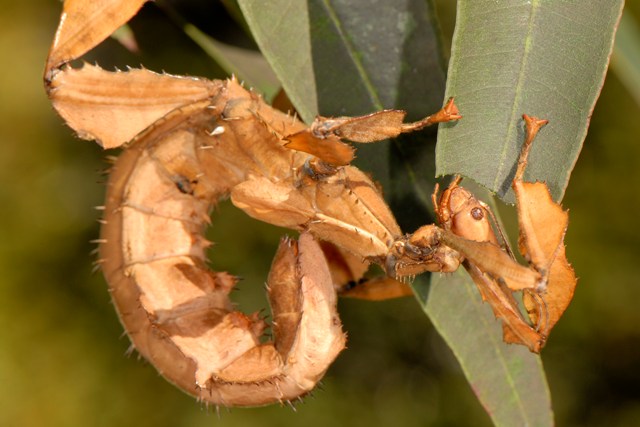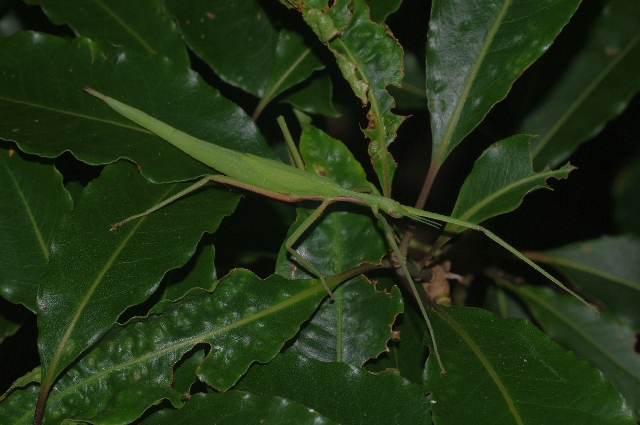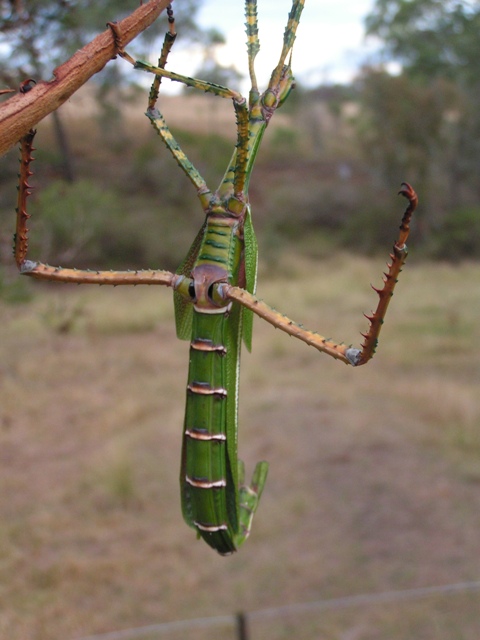Key to Australian Freshwater and Terrestrial Invertebrates
Phylum Arthropoda
Subphylum Hexapoda
Class Insecta
Order Phasmatodea
Common names: phasmids, stick insects, leaf insects
Overview
Phasmatodea, or stick insects, as their common name suggests, tend to be elongate and cylindrical, resembling sticks; some resemble grass or are flattened, resembling leaves; and many bear spines, horns or protuberances. They have two pairs of wings, the forewings are short and hardened, forming a protective cover over part of the larger membranous hindwings; however, many Australian species (particularly the females) are wingless (apterous) or have reduced wings (brachypterous). Even when fully winged they are weak, clumsy fliers, usually flying for short bursts. Phasmids have chewing (mandibulate) mouthparts, long or short, segmented antennae and two moderately long cerci at the end of their abdomen. In males, the tip may be modified into clasping organs. Typically, phasmids are large. ranging in size from 30�300 mm and some species are among the world's largest insects, e.g. females of the goliath stick insect (Eurycnema goliath) which occurs over much of northern and eastern Australia, may to grow up to 25�30 cm in length. Despite their large size, their solitary, arboreal lifestyle means phasmids are rarely encountered; however, after windy weather or storms they may be found on the ground or in low foliage.
Distribution and diversity
Stick insects are found throughout much of Australia particularly in habitats with considerable tree and shrub cover. Those species known strictly as leaf insects are only found in northern Queensland. Globally, phasmids occur in most temperate and tropical ecosystems and over 3,000 species have been described, but further taxonomic revision is required and many new species await description. The described Australian phasmid fauna comprises 105 species in 49 genera and two families; estimates are given of 150 species when all are described.
Life cycle
Sexual dimorphism is common in phasmids: typically the males are winged, smaller and more graceful and mobile than the heavier females which are often wingless or have reduced, non-functioning wings. Usually, it is the males that fly around to locate a mate. Parthenogenesis occurs frequently in phasmids. When mating does occur, sperm transfer is direct. Phasmid eggs are large, hard and often distinctively shaped and sculptured, resembling plant seeds. Depending on the species, females can lay between 100�1,000 eggs; these are laid singly and may be dropped, flicked, buried, glued to a surface, or riveted to a leaf. The eggs of some species are collected by seed-harvesting ants that stockpile the eggs inside their nest where they eventually hatch. The eggs may hatch in the season during which they were laid, or remain in the litter to hatch up to three seasons later, depending on conditions. Stick insect nymphs may or may not resemble adults. In many species the first instar nymph may mimic the ant species that collected the eggs and in whose nest they hatch. Nymphs moult several times before reaching maturity, and development may take from a few weeks to a few months; males undergo fewer moults than females.
Feeding
All phasmids, both adults and nymphs, are herbivores. Typically, they feed nocturnally on the leaves of trees (especially Eucalyptus in Australia) and shrubs. A few species feed on grasses. They are unusual for herbivorous insects in that they can develop successfully on a wide variety of unrelated plant species.
Ecology
Phasmids may be found on the foliage of trees, shrubs, herbs, and grass tussocks upon which they feed, or in the leaf litter. In addition to their spectacularly camouflaged body forms, phasmids also have several other mechanisms that afford protection from predators. They are capable of remaining motionless for long periods of time or may sway gently in the breeze like their plant hosts. When disturbed they may remain still, sway or act dead and drop to the ground and remain motionless, sometimes for hours. Alternatively, some species rapidly raise brightly coloured wings, creating a fluttering or hissing sound by rubbing the hindwings against tubercles on the legs. Some species shed legs when attacked, growing them back (visible at subsequent moults) over time while others can regurgitate their crop contents or squirt an irritating milky fluid at intruders when disturbed. Some populations of stick insects can increase to such large numbers that they become pests, defoliating entire stands of trees. The ringbarker phasmid, Podacanthus wilkinsoni, is a pest of Eucalyptus forests as it can occasionally occurs in large numbers causing severe defoliation. In heavily infested areas this species has even been known to eat the bark. One species, the endemic Lord Howe Island stick insect (Dryococelus australis), was thought to have been driven to extinction by introduced rats. It was rediscovered in 2001 on the offshore erosional remnant, Ball's Pyramid, and is now being successfully bred in captivity with the ultimate aim of reintroducing it to Lord Howe Island.











